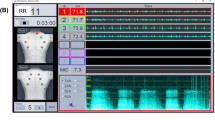Abstract
Auscultatory percussion of the chest is a clinical examination method that has been purported to detect intrapulmonary masses by their effect on transmission of the percussion note to the posterior chest. Recent findings from this laboratory suggested that the sound of sternal percussion may actually travel through the chest cage and not the lung parenchyma. To investigate this possibility further, we recorded the sound produced by sternal percussion at 63 evenly spaced points over the posterior chest wall of 3 healthy subjects and 4 patients with large, discrete intrathoracic lesions in the right upper lobe (2 patients), left lower lobe, and left upper lobe (1 patient each). We constructed 3-dimensional contour maps of the indices of sound amplitude and frequency to view graphically the pattern of distribution of the sound. Examination of the maps revealed areas of increased amplitude in the zones of projection of some osseous structures, especially the scapulae, both in the healthy subjects and patients. No disturbances in the pattern reflecting the presence of mediastinal structures or intrathoracic lesions were found despite the existence of deeply situated lung masses as large as 10 cm in diameter. These findings support the argument that the sound of sternal percussion travels to the posterior chest predominantly through chest wall structures.
Similar content being viewed by others
References
Bates B (1979) A guide to physical examination, 2nd ed. JB Lippincott, Philadelphia/Toronto
Bishop FW, Lee YW, Scott WJM, Lyman RS (1930) Studies on pulmonary acoustics. Am Rev Tuberc 22:347–378
Bohadana AB, Coimbra FTV, Santiago JRF (1986) Detection of lung abnormalities by auscultatory percussion: a comparative study with conventional percussion. Respiration 50:218–225
Bohadana AB, Kraman SS Transmission of sound generated by sternal percussion. J Appl Physiol 1989;66(1):273–277
Delp MH, Manning RT (1975) Major’s physical diagnosis. WB Saunders, Philadelphia
Dosani RA, Kraman SS (1982) Lung sound intensity mapping in normal men. Chest 83:628–31
Guarino JR (1975) Auscultatory percussion. A new aid in the examination of the chest. J Kansas Med Soc 75:193–194
Guarino JR (1980) Auscultatory percussion of the chest. Lancet 1:1332–1334
Hansen LB, Brons M, Nielsen NT (1986) Auscultatory percussion of the lung. Prospective comparison of two methods of clinical examination of the lungs. Ugeskr Laeger 148:323–325
Kraman SS (1983) Does the vesicular lung sound come only from the lungs? Am Rev Respir Dis 128:622–626
McKusick VA, Jenkins JT, Webb GN (1955) The acoustic basis of chest examination. Studies by means of sound spectrography. Am Rev Tuberc 72:12–34
McLain DH (1985) Drawing contours from arbitrary data points. Comput J 17:318–324
Rice DA (1985) Transmission of lung sounds. Semin Respir Med 6:166–170
Author information
Authors and Affiliations
Rights and permissions
About this article
Cite this article
Bohadana, A.B., Patel, R. & Kraman, S.S. Contour maps of auscultatory percussion in healthy subjects and patients with large intrapulmonary lesions. Lung 167, 359–372 (1989). https://doi.org/10.1007/BF02714964
Accepted:
Issue Date:
DOI: https://doi.org/10.1007/BF02714964




